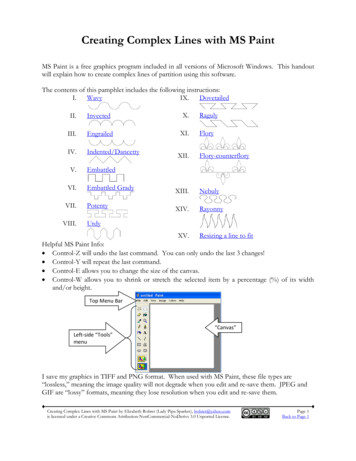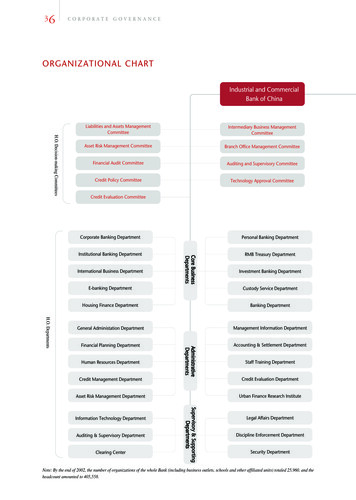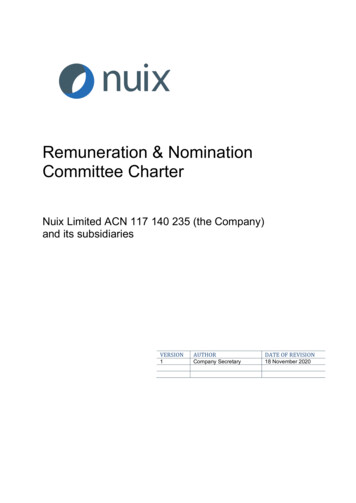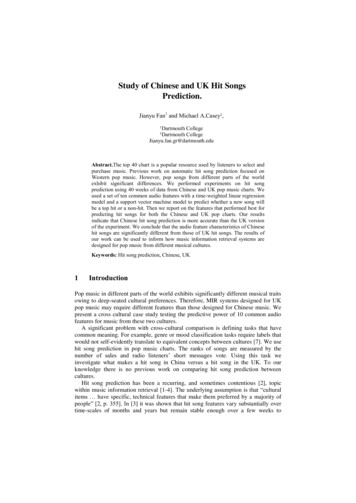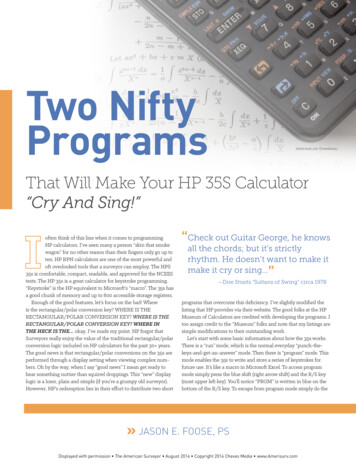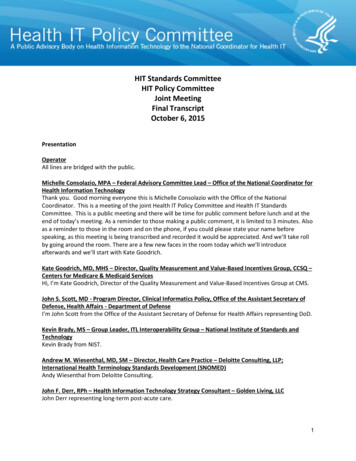
Transcription
HIT Standards CommitteeHIT Policy CommitteeJoint MeetingFinal TranscriptOctober 6, 2015PresentationOperatorAll lines are bridged with the public.Michelle Consolazio, MPA – Federal Advisory Committee Lead – Office of the National Coordinator forHealth Information TechnologyThank you. Good morning everyone this is Michelle Consolazio with the Office of the NationalCoordinator. This is a meeting of the joint Health IT Policy Committee and Health IT StandardsCommittee. This is a public meeting and there will be time for public comment before lunch and at theend of today’s meeting. As a reminder to those making a public comment, it is limited to 3 minutes. Alsoas a reminder to those in the room and on the phone, if you could please state your name beforespeaking, as this meeting is being transcribed and recorded it would be appreciated. And we’ll take rollby going around the room. There are a few new faces in the room today which we’ll introduceafterwards and we’ll start with Kate Goodrich.Kate Goodrich, MD, MHS – Director, Quality Measurement and Value-Based Incentives Group, CCSQ –Centers for Medicare & Medicaid ServicesHi, I’m Kate Goodrich, Director of the Quality Measurement and Value-Based Incentives Group at CMS.John S. Scott, MD - Program Director, Clinical Informatics Policy, Office of the Assistant Secretary ofDefense, Health Affairs - Department of DefenseI’m John Scott from the Office of the Assistant Secretary of Defense for Health Affairs representing DoD.Kevin Brady, MS – Group Leader, ITL Interoperability Group – National Institute of Standards andTechnologyKevin Brady from NIST.Andrew M. Wiesenthal, MD, SM – Director, Health Care Practice – Deloitte Consulting, LLP;International Health Terminology Standards Development (SNOMED)Andy Wiesenthal from Deloitte Consulting.John F. Derr, RPh – Health Information Technology Strategy Consultant – Golden Living, LLCJohn Derr representing long-term post-acute care.1
Lorraine Doo, MSWA, MPH – Senior Policy Advisor – Centers for Medicare & Medicaid Services –Health & Human ServicesLorraine Doo with the Centers for Medicare & Medicaid Services.Paul Egerman – Businessman/Software EntrepreneurPaul Egerman and new title, grandfather.Eric Rose, MD, FAAFP – Director of Clinical Terminology – Intelligent Medical ObjectsEric Rose, Intelligent Medical Objects.Arien Malec – Vice President Strategy & Product Marketing – RelayHealth CorporationArien Malec, RelayHealth.Angela Kennedy, EdD, MBA, RHIA – Head & Professor Health information Management – LouisianaTech UniversityAngela Kennedy, Louisiana Tech University; I represent the consumer.Joshua C. Mandel, MD, SB – Research Scientist – Boston Children’s HospitalJosh Mandel, Boston Children's Hospital, Harvard Medical School.Richard Elmore – President, Strategic Initiatives – AllscriptsRich Elmore, Allscripts.Brian P. Burns, MA - Deputy Director, Office of Information and Technology - Department of VeteransAffairsBrian Burns, Department of Veterans Affairs.Steven Posnack, MHS, MS, CISSP – Director, Office of Standards and Technology – Office of theNational Coordinator for Health Information TechnologySteve Posnack, ONC.P. Jonathan White, MD – Deputy National Coordinator – Office of the National Coordinator for HealthInformation TechnologyJon White, ONC.Paul Tang, MD, MS – Vice President, Chief Innovation and Technology Officer – Palo Alto MedicalFoundationPaul Tang, Palo Alto Medical Foundation.John Halamka, MD, MS – Chief Informatics Officer – Harvard Medical School/Beth Israel DeaconessMedical CenterJohn Halamka, Beth Israel Deaconess Medical Center.Karen B. DeSalvo, MD, MPH, MSc – National Coordinator – Office of the National Coordinator forHealth Information Technology – Department of Health & Human ServicesKaren DeSalvo, ONC.2
Jodi G. Daniel, JD, MPH – Director, Office of Policy – Office of the National Coordinator for HealthInformation TechnologyJodi Daniel, ONC.Patricia P. Sengstack, DNP, RN-BC, CPHIMS – Chief Nursing Informatics Officer – Bon Secours HealthSystemPatty Sengstack, Bon Secours Health System.Leslie Kelly Hall – Senior Vice President of Policy – HealthwiseLeslie Kelly Hall, Healthwise and the Informed Medical Decision Making Foundation.David F. Kotz, PhD – Associate Dean of the Faculty for the Sciences – Dartmouth CollegeDavid Kotz, Dartmouth College.Lisa Gallagher, BSEE, CISM, CPHIMS – Vice President, Technology Solutions – Healthcare Information &Management Systems SocietyLisa Gallagher, HIMSS.Anjum Khurshid, PhD, MPAff, MBBS – Director, Health Systems Division – Louisiana Public HealthInstituteAnjum Khurshid, representing Louisiana Public Health Institute.Elizabeth Johnson, MS, FHIMSS, CPHIMS, RN-BC – Chief Clinical Informatics Officer & Vice President,Applied Clinical Informatics –Tenet Healthcare CorporationLiz Johnson, Tenet Healthcare.Christoph U. Lehmann, MD, FACMI, FAAP – Professor, Pediatrics & Biomedical Informatics –Vanderbilt University School of MedicineChris Lehmann, Vanderbilt University and representing under-represented populations.Anne LeMaistre, MD – Senior Director Clinical Information Systems and CMIO – Ascension HealthAnne LeMaistre, Ascension.Neal Patterson, MBA – Chairman of the Board and Chief Executive Officer – Cerner CorporationNeal Patterson, Cerner.Troy Seagondollar, RN-BC, MSN, UNAC/UHCP – Regional Technology Nursing Liaison – InformaticsNurse – Kaiser PermanenteTroy Seagondollar, Kaiser Permanente and labor representative.Rebecca D. Kush, PhD – Founder, Chief Executive Officer, President & Director – Clinical DataInterchange Standards Consortium (CDISC)Becky Kush, CDISC, representing clinical research standards.Brent G. Snyder, MBA, Esq. – Chief Information Officer – Adventist Health SystemBrent Snyder, Adventist Health System.3
Jamie Ferguson – Vice President, Health Information Technology Strategy & Planning, Fellow, Institutefor Health Policy – Kaiser Permanente, Institute for Health PolicyJamie Ferguson, Kaiser Permanente.Dixie Baker, MS, PhD – Senior Partner - Martin, Blanck & AssociatesDixie Baker, Martin, Blanck & Associates.Elise Sweeney Anthony, Esq – Senior Policy Advisor – Office of the National Coordinator for HealthInformation TechnologyElise Sweeney Anthony, ONC.Michelle Consolazio, MPA – Federal Advisory Committee Program Lead – Office of the NationalCoordinator for Health Information TechnologyOn the phone caught do we have David Lansky?David Lansky, PhD – President & Chief Executive Officer – Pacific Business Group on HealthYes; thank you, Michelle.Michelle Consolazio, MPA – Federal Advisory Committee Program Lead – Office of the NationalCoordinator for Health Information TechnologyHi David. Scott Gottlieb?Scott Gottlieb, MD – Resident Fellow & Practicing Physician – American Enterprise InstituteI’m here; how are you?Michelle Consolazio, MPA – Federal Advisory Committee Program Lead – Office of the NationalCoordinator for Health Information TechnologyHi, Scott. And Cris Ross.Cris Ross, MBA – Chief Information Officer – Mayo ClinicGood morning; this is Cris Ross from Mayo.Michelle Consolazio, MPA – Federal Advisory Committee Program Lead – Office of the NationalCoordinator for Health Information TechnologyHi, Cris. Anyone else on the phone?Wes Rishel – Independent ConsultantWes Rishel.Anne Castro – Vice President, Chief Design Architect – BlueCross BlueShield of South CarolinaYes, Anne Castro Michelle Consolazio, MPA – Federal Advisory Committee Program Lead – Office of the NationalCoordinator for Health Information TechnologyI heard Anne Castro and Wes Rishel.Wes Rishel – Independent ConsultantYup.4
Anne Castro – Vice President, Chief Design Architect – BlueCross BlueShield of South CarolinaYes.Michelle Consolazio, MPA – Federal Advisory Committee Program Lead – Office of the NationalCoordinator for Health Information TechnologyOkay. Well thank you, it’s a cozy room today but we’ll make it work. And so with that, I’m going to turnit over to you, Karen.Karen B. DeSalvo, MD, MPH, MSc – National Coordinator – Office of the National Coordinator forHealth Information Technology – Department of Health & Human ServicesThank you, Michelle. Good morning, so, do you want me to do the introductions of new members or didyou want to do that?Michelle Consolazio, MPA – Federal Advisory Committee Program Lead – Office of the NationalCoordinator for Health Information TechnologyI’m sorry, I meant to do that.Karen B. DeSalvo, MD, MPH, MSc – National Coordinator – Office of the National Coordinator forHealth Information Technology – Department of Health & Human ServicesOkay.Michelle Consolazio, MPA – Federal Advisory Committee Program Lead – Office of the NationalCoordinator for Health Information TechnologySo we have a few new members. We did announce the Standards Committee members on the last call,but they’re here with us in person. Jitin Asnaani unfortunately is not here with us but we do have AngelaKennedy, Rich Elmore, Josh Mandel and Patty Sengstack here with us today, so welcome them. It’s sonice to meet you in person and it’s an exciting first meeting to have both Policy and StandardsCommittee together. And we also from the Policy Committee have Brian Burns with us, who was ournew VA representative, so welcome to Brian as well.Karen B. DeSalvo, MD, MPH, MSc – National Coordinator – Office of the National Coordinator forHealth Information Technology – Department of Health & Human ServicesWonderful. Thank you, Michelle and thanks everybody for being here today and we appreciate you alladjusting to the close quarters. We had heard a lot of feedback that having joint committee meetingswas really helpful, especially when we’re talking about work like the Interoperability Road Map that haspolicy and technology considerations in it and that it’s a good chance for us to have some shareddialogue in this space.I want to just make some overall remarks about framing our conversation today and give you all a senseof what we are wanting to accomplish and get some feedback from you all on. We’re going to start witha sort of check-in about where we are with data on the Meaningful Use Program, which has been a verysuccessful program at encouraging adoption and starting to advance the exchange of electronic healthinformation. It’s a program that you all many of you had a hand in helping us develop for this countryand was one that rewarded doctors and hospitals to use technology.5
I think clearly where the world is moving very quickly and where we at HHS want to help lead thattransition is to reward doctors and hospitals for better care and see that technology is an integral part ofthat care delivery. And that is this delivery system reform effort the department has had is really aboutthat; it’s a three-pronged effort that changes the way we pay for care, the way care is delivered and theway information is distributed.I’m going to walk us through that in the delivery system reform update which some of you have beenthrough and I want to tell you where that is today and just remind everybody that our work here isnested within a really important short-term priority that we have in the department and theadministration to see that we build a person-centered system that is going to enable them. Becausethey have the kind of information available to make their own decisions, but that the health care systemcan make better decisions because the information is there for them and quite frankly so we can takenew payment models to scale, which we won’t be able to do unless we have the information available.Then I’m going to hand it over to my colleague at CMS. Kate’s going to talk about this opportunity thatwe have going forward in the MACRA legislation. This is the came out of the SGR fix. This is front on ourminds; we just put out an RFI recently to help get some feedback about not just the payment models,but please for this group remember that there are expectations for ONC in that legislation about howwe help technology advance in such a way that it can support new payment models.Again we’re already working on a delivery system reform, but very acute and clear timelines within theMACRA legislation. So this is moving us from a world of fee-for-service to value-based, not just payment,the value-based models that support community and overall health. So we’re going to need you all’sassistance in thinking through how we can enable and make those real for doctors on the ground andhospitals out in the field as we think more broadly about payment reform; so that’s what Kate’s going totalk about.Then we’re going to take a break and then we’re going to talk about one of these really importantstreams of work in this better care, smarter spending, healthier people delivery system reform modelwhich is we’re going to get information available to make better decisions for everybody on the frontline, and that’s the interoperability roadmap that so many of you have had a hand in developing.We really appreciate the thoughtful input and I think we’ve had some conversations with a lot of folks inthe last few days as we’re thinking about how what we’re going to commit to as federal partners isgoing to match up with what the private sector is able to commit to and how we’re going to reallycatalyze this. Thinking a lot about this in the last few days and I’ll just make two closing comments.So one is, whenever we’re not sure where to go, we always remind ourselves at ONC that this is aboutthe people of this country, this is about the average American whether they live in a rural community oran urban community, no matter the time zone. I wore my Walking Gallery jacket today on purpose tohelp me and all of us remember that this is about the, not just the patient but the consumer and thecommunity that we’re here to serve. So whenever things feel sticky, let’s keep that in mind, that we’redoing this for them.6
In the second place, I just want to make a comment about the importance of federal and private sectorpartnership throughout all of this work. It’s why we’re reaching out to get feedback on things likeMACRA. The work that we do as the federal partner in this across administration is, we have broad bluntinstruments that set broad guardrails and direction and can enable and push policy that sometimesdoesn’t touch the ground, doesn’t touch the clinic room for some period of time. And so we’re reallycounting on you guys to work with us so that feels palpably different to average doctor, average patient,every day, as soon as possible. Because the sense of urgency that they feel, we share but it’s going torequire all of us working in concert.So that’s what we’re our agenda is for today, to tell you where we are with our program to encouragethe use of technology and really move us to this new world which we in of encouraging better care. Andtechnology is a key part of that and start to think about how we’re going to iterate technology to makethat a reality and what we are proposing in the roadmap. So thank you guys very much; thank you againfor being here.Paul Tang, MD, MS – Vice President, Chief Innovation and Technology Officer – Palo Alto MedicalFoundationGood. Thank you, Karen and Karen went over the agenda and it’s really logical from where we’ve beenand where we’re headed and just echo some comments about Meaningful Use. If you remember the ofcourse the first part of that Stage 1 was to get data in these systems and in front of people. Did a greatjob at doing that. The second one is to get the data all over the place where it needs to be and notwhere doesn’t need to be, and we’re in the middle of that.And the thirdly was always focused on outcomes and I think it was also we knew ahead of time therewas going to be a handoff or we’re hoping for a handoff, Meaningful Use having preceded ACA by ayear. But hoping there’d be a handoff to the delivery system reform in a sense, of having the right kindof payment model and also having the right kind of systems where we have team-based care tocoordinate ways that we both support health and healthcare.So I think this is the nexus between where we were in getting these systems in place to where we’reheaded, which is to reconfigure to reform the delivery system. So, it’s a nice spin off to point. John?John Halamka, MD, MS – Chief Informatics Officer – Harvard Medical School/Beth Israel DeaconessMedical CenterDo you want to get your minutes approved now or later?Paul Tang, MD, MS – Vice President, Chief Innovation and Technology Officer – Palo Alto MedicalFoundationSo we have two minutes now to approve. One, and I realize you got this very recently; if you had achance to look at it is we were asking for approval of the minutes that were distributed for the PolicyCommittee and John’s going to do the Standards Committee. I entertain the moment a movement toapprove the Policy Committee minutes.Paul Egerman – Businessman/Software EntrepreneurSo moved.7
Paul Tang, MD, MS – Vice President, Chief Innovation and Technology Officer – Palo Alto MedicalFoundationThank you, Paul. Second?MSecond.Paul Tang, MD, MS – Vice President, Chief Innovation and Technology Officer – Palo Alto MedicalFoundationThank you. And any further discussion or amendments? Okay, all in favor?Multiple speakersAye.Paul Tang, MD, MS – Vice President, Chief Innovation and Technology Officer – Palo Alto MedicalFoundationAnd opposed or abstain? Thank you. John?John Halamka, MD, MS – Chief Informatics Officer – Harvard Medical School/Beth Israel DeaconessMedical CenterThank you. And of course, do want to welcome our new members, Josh, Patty, Angela, Rich and Jitin,who couldn’t be here today. And it is great to see infusion of new ideas and new energy. I think youknow what is this, our 75th meeting or something of the Standards Committee. So if nothing else, wehave lots of frequent flyer miles.But again, thank you for your service and look forward to the day, as Karen has said, as I look at theaccountable care organization activity in my state, the kind of interoperability we need are no longerjust driven by Meaningful Use, they’re existential; if we don’t share data for care coordination, reducingredundancy and waste, improving quality, safety and efficiency, we can’t survive. The margins of ourhealthcare systems in Massachusetts are about 1% and so it is now driving us to build new kinds ofdatabases and new kinds of, as you say, team-based care and thinking about new ways to be go beyondtransition of care summaries.So today is going to be very interesting; we’ll hear the framing remarks, as Karen said, and then in theafternoon we’ll be talking about the interoperability roadmap and there will be lots of opportunity fordiscussion. And so I look forward to that. Other than that I did ask, as I always do, I said Jon White, soare we going to hear about MU 2, MU 3, anything in the future? Not yet. So there you go, free forpoliticos listening, you know, we’re going to do all the substantive stuff, no rumor, no innuendo.Karen B. DeSalvo, MD, MPH, MSc – National Coordinator – Office of the National Coordinator forHealth Information Technology – Department of Health & Human ServicesRight.John Halamka, MD, MS – Chief Informatics Officer – Harvard Medical School/Beth Israel DeaconessMedical CenterBut most importantly I think I want to turn it over to Jon White to talk about Jodi because Jodi and Ihave served together since what, the very earliest days of David Brailer and so Jon.8
P. Jonathan White, MD – Deputy National Coordinator – Office of the National Coordinator for HealthInformation TechnologyYeah, all right. This is the job that I really don’t want, but I’m going to take. Okay, so first, I do want towelcome everybody. It’s really nice to see you all here, you know in a location that has a lot of history inWashington. The Omni Shoreham has been around for a long time, a lot of things have happened here.And similarly, this meeting and this week really kind of mark a bittersweet close to a chapter in ONChistory and the history of health IT in our country and that is because Jodi Daniel, the Director of ourOffice of Policy, is leaving us after over a decade of service at ONC.You know, as somebody who has recently left a job that I loved for where I spent a decade, I have a lotof sympathetic feelings about this and I know kind of probably the struggle that you went through to tryto make the decision. And it’s bittersweet because, not only are we having to say goodbye to you, butwe know that amazing things lie ahead in your future and our future work together.So, you know, there’s really no way for me to capture not just, you know, 10 years’ worth of publicservice, but really all of the things that Jodi does and has done. So I’m not going to try; there’s just noway. My ask for all of you here who have worked with Jodi over the years is please take the time tocome find Jodi today and speak with her and tell her what her services meant to you because really atthe end of the day, it’s the connections with those of us here in the room and listening who that reallymean a tremendous amount to us as individuals who.so, I’ll simply say this; Jodi, you are fiercelyintelligent, you are a staunchly loyal colleague and co-worker for those that you work with, for and whowork for you and is extremely valued by all of us, more than probably you will ever know.And most importantly, you are the most one of the most deeply committed public servants that I haveever met in my life. And as somebody who has committed their life to public service that has meaningnot just for me and not just for the people here, but for the people across the entire country. And thereis really no better honorific that this son of Virginia can offer to you than to say, it has been an honor toserve with you. Thank you, Jodi.John Halamka, MD, MS – Chief Informatics Officer – Harvard Medical School/Beth Israel DeaconessMedical CenterAnd we do have the matter of the minutes from the Standards Committee. So, we do things a little bitdifferently in the Standards Committee; it’s all by consensus and collaboration, it’s a lovely thing. Arethere any objections to the minutes?Karen B. DeSalvo, MD, MPH, MSc – National Coordinator – Office of the National Coordinator forHealth Information Technology – Department of Health & Human ServicesYou’re balloting?John Halamka, MD, MS – Chief Informatics Officer – Harvard Medical School/Beth Israel DeaconessMedical CenterNone being heard, they are approved by consensus. Thank you.9
Paul Tang, MD, MS – Vice President, Chief Innovation and Technology Officer – Palo Alto MedicalFoundation this way. I want to thank Jodi, too. I’ve worked with her the entire tenure I’ve had here and this hasbeen an incredibly productive Federal Advisory Committees, sub-committees and Jodi’s been at theheart of that. Jodi did have a career before the ONC and she actually played a big role in HIPAA as well.So, there’s a lot of ways that her work has touched all of our lives and the lives of the residents of thiscountry so thank you so much.Karen B. DeSalvo, MD, MPH, MSc – National Coordinator – Office of the National Coordinator forHealth Information Technology – Department of Health & Human ServicesThank you, Paul. Can I just I just want to step on all that and say Jodi G. Daniel, JD, MPH – Director, Office of Policy – Office of the National Coordinator for HealthInformation TechnologyAre you going to try to make me cry?Karen B. DeSalvo, MD, MPH, MSc – National Coordinator – Office of the National Coordinator forHealth Information Technology – Department of Health & Human ServicesI am didn’t have a tissue, so no, I won’t do that to you Jodi. But I, you know, they’re right in everythingthat they say. Jodi has an extraordinary intellect and she’s just in addition to all the contributions thatshe’s made for actually 15 years of public service and 10 at ONC and including her deep understandingof HIPAA, her deep understanding of health IT policy, not just within the federal government, but morebroadly. She’s a great mentor and teacher and I have learned so much from her about public service andabout what the way that we can use, as Jodi says, our superpowers for good and also how when it’sappropriate, for us to step down.So I think there’s a really nice balance and she’s just done a great job of as an advisor and a mentor anda she’s done a great job with her staff. I think she’s just really helped develop some very fine talent inher shop. So I just want to thank her as a citizen for her public service but also as someone who’s beenon this team with her for the last couple of years, it’s really been terrific. We’re going to miss you.Jodi G. Daniel, JD, MPH – Director, Office of Policy – Office of the National Coordinator for HealthInformation TechnologyI’m sitting next to a nurse so I’ve got tissue.Patricia P. Sengstack, DNP, RN-BC, CPHIMS – Chief Nursing Informatics Officer – Bon Secours HealthSystem take care of that.Jodi G. Daniel, JD, MPH – Director, Office of Policy – Office of the National Coordinator for HealthInformation TechnologyOkay, and that’s maudlin. Beth here?John Halamka, MD, MS – Chief Informatics Officer – Harvard Medical School/Beth Israel DeaconessMedical CenterSo I believe we, Michelle are now turning the meeting over to Elizabeth Holland?10
Michelle Consolazio, MPA – Federal Advisory Committee Program Lead – Office of the NationalCoordinator for Health Information TechnologyShe is on the phone.Elizabeth Holland, MPA – Senior Technical Advisor - Centers for Medicare & Medicaid ServicesHi, I’m on the phone; can you hear me?Michelle Consolazio, MPA – Federal Advisory Committee Program Lead – Office of the NationalCoordinator for Health Information TechnologyWe can hear you.Elizabeth Holland, MPA – Senior Technical Advisor - Centers for Medicare & MedicaidOkay, great. So I’m going to talk about the Medicare & Medicaid EHR Incentive Programs, just what I cansay. I am with the Quality Measurement and Value-Based Incentives Group, so I work with KateGoodrich at CMS. First, we’ll talk about registrations for the program.So, registration has continued to be open for the programs throughout the year. So you can see ourAugust numbers; we’re continuing to have providers register. It is interesting that we’ve had as manyMedicare eligible professionals register as we have; it’s too late now for them to initiate the programand earn an incentive payment, but they continue to register. For the Medicaid eligible professionals,they can still initiate and earn incentive.So next slide to the Medicare provider count. So this is your breakout between Stage 1 and Stage 2. AndI’ll remind everyone, as has been discussed before, the Stage 2 numbers are reduced because of theflexibility that we did offer last year. So, we offered flexibility for those who had difficulty implementingtheir EHR technology certified to the 2014 Edition, so we enabled them to have the opportunity toeither use 2011 or technology certified to the 2014. So some providers who were choosing to use their2011 certified products, had to do Stage 1, they couldn’t Stage 2 even if they wanted to because theirtechnology didn’t offer them the appropriate measures that they needed to do Stage 2. So, those areour divisions between the stages.Next slide, attestation for 2015. So as I previously stated, we have the registration numbers for 2015because registration has been open, but for 2015 attestation has not been open. Due to the proposedmodifications that we proposed, as you know, on April 15 we released a proposed rule that includedmodifications for 2015 through 2017. And due to the changes we proposed, such as a change to the EHRreporting period in 2015 and other proposals meant to make the program more flexible and simpler, wehave not been able to have attestation open.So we did hear from some hospitals who were first-time hospital participants, who wanted to be firsttime participants who had worked really hard implementing their electronic health records and werefinally ready to attest and then they came to us and said well attestation is not open, what can we do?So we did open a special window for them to come in and to attest because first-year providers do havea 90-day reporting period, according to the current rules. So we did have probably between 60 and 70eligible hospitals and CAHs who were in their first year of participation come through with using thewindow that was in July and August.11
So once we release our final rule, hopefully soon, we will be able to modify our attestation system andthen we will be able to open attestation in January. So it is our intention that attestation will be openfrom January 4, 2016 through February 29, 2016 for all providers to attest for 2015 or EHR reportingperiods in 2015.Moving on to the provider summary. As you see, there’s a big gap in providers paid for the 2015program year and that’s because of attestation. Medicaid, many states still have their attestation openfor 2015, so that’s why you see that there are numbers for Medicaid in 2015. And as I mentioned, wehad hospitals come in and some of them had been paid. It usually takes us a little longer to pay criticalaccess hospitals, so that’s why the number isn’t as high as the 60-70 that I mentioned, but thosenumbers should be going up throughout the fall, as we get documentation we need to pay CAHs andthey’ll get paid as well.To my last slide, provider payments. As you see, the number of providers tracked with the providerpayments are the money that we’ve moved this year is very small because of attestation not beingopen. But we expect that we will be paying lots of people after the attestation period in January andFebruary. So, that’s all I really have for today, but I’d be happy to answer any questions if there are any.Paul Tang, MD, MS – Vice President, Chief Innovation and Technology Officer – Palo Alto MedicalFoundationOkay, thanks, Beth. Questions or commen
Josh Mandel, Boston Children's Hospital, Harvard Medical School. Richard Elmore - President, Strategic Initiatives - Allscripts . DNP, RN-BC, CPHIMS - Chief Nursing Informatics Officer - Bon Secours Health . Patty Sengstack, Bon Secours Health System. Leslie Kelly Hall - Senior Vice President of Policy - Healthwise Leslie Kelly .

